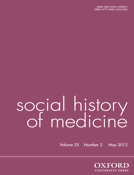-
Views
-
Cite
Cite
Barbara Böck, Markham J. Geller, Ancient Babylonian Medicine: Theory and Practice, Social History of Medicine, Volume 25, Issue 2, May 2012, Pages 554–555, https://doi.org/10.1093/shm/hkr161
Close - Share Icon Share
Extract
Merely 15 per cent of the written documentation on ancient Babylonian medicine is available in updated translations; most of the cuneiform material can only be found in edited hand copies of cuneiform inscriptions, and a considerable amount still remains unpublished. This is one of the principal reasons why little is known about the ancient Mesopotamian healing systems. M. J. Geller is one of the few Assyriologists who have specialised in this very field. For more than twenty years he has contributed to the study of different aspects of magical and non-magical healing therapies, focusing in the last years on renal and rectal diseases.
With the present study, bearing the ambitious subtitle Theory and Practice, Geller intends to examine ‘how medicine (and to a lesser extent, magic) evolved in Babylonia’ and ‘to view the state of art of Babylonian medicine in its final period of maturity, in the second half of the first millennium BC’ (p. 10). Geller illustrates the interaction between these two ultimately inseparable aspects by discussing the scope of activities and range of responsibilities of the two main endemic healing professions of ancient Mesopotamia, usually translated as ‘physician’ (asû) and ‘exorcist’ (mašmaššu or āšipu), on the basis of the written documentation from the second and first millennium BC. Here he follows the traditional approach, going back to the influential article by Edith Ritter, published in 1965. Ritter came to the conclusion that non-magical practices can be attributed to the ‘physician’ while the ‘exorcist’ covered the magical realm. Geller understands both approaches to healing as independent and competing systems, concluding that the two professions 'can be described as ‘magic’ versus “medicine”' (p. 167).




